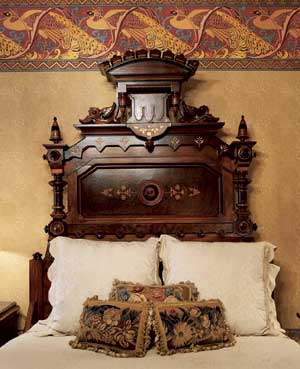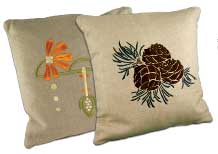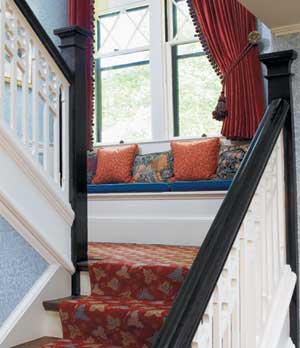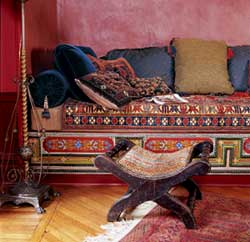Floral tapestry pillows with deep ball fringe are the perfect counterpoint for a late-19th-century Renaissance Revival bed. Alan Weintraub photo
The decorative pillow is one of the hallmarks of leisure. It’s pretty, comfortable, and not really a necessity. Perhaps that’s why the Victorians loved them, as has every generation since.
Women of the late 19th century delighted in creating their own pillows, covering them in tapestry fabrics with deep fringes, embellishing them with lace, or stitching them in needlepoint or petit point, then tucking the resultant works of art against velvet horsehair sofas or in an opulent pile in a Turkish corner (the more pillows, the better).
The availability of patterns published in women’s magazines or for individual sale led to an astounding number of designs, many of them thematic. Women made them for home decoration, but also for gifts; many patterns suggested a sentiment or contained a message. Embroidered tea roses, for example, signified remembrance; lilies of the valley, the return of happiness. Other mottos were more clear-cut, especially as the 19th century folded into the 20th: “Home Sweet Home” appeared on pillows as well as wall hangings, and the embroidered name of a state was a memento of one’s travels.
The pinecone is the quintessential Arts & Crafts motif, while flowers are common to all eras. These pillows are from Ford Craftsman Studios.
As Victorian excess in home furnishings waned, a new style of accent pillow appeared, inspired by simplicity. A typical pillow of the Arts & Crafts era usually sported a single motif, embroidered in muted colors on buff-colored linen. In both The Craftsman and his home furnishings catalogs, Gustav Stickley suggested and published plans for motifs in keeping with the Craftsman philosophy. According to Ann Wallace, writing in Arts & Crafts Textiles [Gibbs Smith, 1999], “Pinecone” was probably Stickley’s most popular design, especially when stuffed with balsam fir. (Stickley’s kit sold for $1.75; a finished pillow was $5.)
Tapestry pillows in William Morris designs accent a window seat on the stair landing of a Colonial Revival home. In the 1940s and ’50s, interior designers hit on the idea of using pillow fabrics with subtle similarities and differences in both color and texture as accents. Greg Premru photo
For the first time, the idea of middle class comfort included accent pillows. Inglenooks, the built-in benches around the fireplace, were often loaded with hand-embroidered pillows to encourage cozy family gatherings. Women’s magazines continued to spread ideas and patterns for new designs, with suggestions like this one from The Modern Priscilla: “Embroidery for the living room should be distinctive, and the coloring gay and cheerful, without being obtrusive enough to clash with any coloring a room may already have.”
This notion of subtlety in accent pillows would continue into the 1920s, ’30s, and even ’40s. Judging from the amount of use in photo spreads in magazines like House Beautiful, pillows were used sparingly as accents in the 1920s until late in the decade. Colors and fabrics tended toward the plain, even matching the fabric on the chair or sofa they were intended to accent. Or the pillow might be of a lighter or darker shade in the same color family (i.e., yellow on warm brown). Most accent pillows apparently were made in solid colors, almost as afterthoughts. Before about 1930, cushions and pillows appeared where surfaces are hard: across seating benches in a ca. 1930 New York apartment kitchen/dining room, against an inglenook or Colonial Revival chair with a high wooden back.
Cozy corners piled high with pillows in rich and exotic fabrics were a favorite treatment in late Victorian rooms. Gross & Daley photo
As the 1930s progressed, however, pillows began to show up in the context of furniture made specifically for lounging (the chaise lounge, window seats, rattan pieces). More daring choices included colors from the opposite side of the color spectrum: burnt orange against blue, or vice versa. Another truly modern departure were pillows in a fabric that matched the curtains, a signature of modern interior design, and a method that opens up and unifies a room.
Plain pillows, on the small side and almost nondescript to contemporary eyes, carried on well into the 1950s and ’60s, usually in jewel tones against the patterned or solid-color fabric of a chair or sofa. While magazine spreads of the 1940s and ’50s often show pillows heaped on a daybed or sofa, solid colors usually predominate, with the decorator mixing in one matching and one contrasting shade, with just a few patterned pillows to draw the eye. While the effect may seem amateurish now, the concepts are still in use today, although with a lot more subtlety and punch.
For pillow and fabric sources, see the Products & Services Directory.







